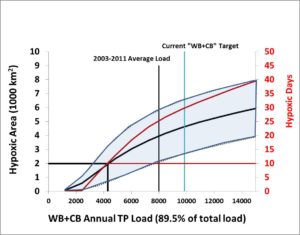 Ecological Forecasting for Lake Erie – In the 1960s and 70s, the status of Lake Erie became a national story when, due to a host of environmental issues, it was declared ecologically “dead” in the media. It was a dramatic statement and not entirely factual, but the phrase did bring attention to what was happening in the Lake Erie ecosystem. Regulations and restoration efforts revived the health of Lake Erie, until the 1990s and more recently, when hypoxic (low oxygen levels) conditions again emerged. Despite the efforts already in place, the lake is showing signs of distress — and more research is needed to figure out why. As a result, the NOAA-funded EcoFore project, short for Ecological Forecasting, began. See press release.
Ecological Forecasting for Lake Erie – In the 1960s and 70s, the status of Lake Erie became a national story when, due to a host of environmental issues, it was declared ecologically “dead” in the media. It was a dramatic statement and not entirely factual, but the phrase did bring attention to what was happening in the Lake Erie ecosystem. Regulations and restoration efforts revived the health of Lake Erie, until the 1990s and more recently, when hypoxic (low oxygen levels) conditions again emerged. Despite the efforts already in place, the lake is showing signs of distress — and more research is needed to figure out why. As a result, the NOAA-funded EcoFore project, short for Ecological Forecasting, began. See press release.
The project created, tested and applied models to forecast how anthropogenic (land use, invasive species) and natural (climatic variability) stresses influence hypoxia formation and ecology, with an emphasis on fish production. Excess nutrients stimulate algae that sink and decompose, depleting oxygen (hypoxia) and impacting fish. EcoFore built some of the first models of drivers and impacts of hypoxia in Lake Erie as input to the International Joint Commission’s Lake Erie Ecosystem Priority report and the Great Lakes Water Quality Agreement. (see [[link to]] Lake Erie & the Great Lakes Water Quality Agreement)
Dozens of peer reviewed papers were published. Our contributions to those are here:
Scavia, D., J. D. Allan, K. K. Arend, S. Bartell, D. Beletsky, N. S. Bosch, S. B. Brandt, R. D. Briland, I. Daloğlu, J. V. DePinto, D. M. Dolan, M. A. Evans, T. M. Farmer,D. Goto, H. Han, T. O. Höök, R. Knight, S. A. Ludsin, D. Mason, A. M. Michalak, R. P. Richards, J. J. Roberts, D. K. Rucinski, E. Rutherford, D. J. Schwab, T. Sesterhenn, H. Zhang, Y. Zhou. 2014 Assessing and addressing the re-eutrophication of Lake Erie: Central Basin Hypoxia. J. Great Lakes Res. 40: 226–246. http://dx.doi.org/10.1016/j.jglr.2014.02.004
Daloglu, I. J.I. Nassauer, R.L. Riolo, D. Scavia 2014 Developing a farmer typology to link agent-based models with SWAT Agricultural Systems
Bosch, N.S., M.A. Evans, D. Scavia, J.D. Allan 2014 Interacting effects of climate change and agricultural BMPs on nutrient runoff. J. Great Lakes Res.
Rucinski, D., D. Scavia, J. DePinto, D. Beletsky 2014 Lake Erie’s hypoxia response to nutrient loads and meteorological variability. J. Great Lakes Res.
Daloglu, I. J.I. Nassauer, R.L. Riolo, D. Scavia 2014 An Integrated Social and Ecological Modeling Framework – Impacts of Agricultural Conservation Practices on Water Quality. Ecology and Society
Bosch N.S., J.D. Allan, J.P. Selegean, D. Scavia 2013 Scenario-testing of agricultural best management practices in Lake Erie watersheds. J. Great Lakes. Res. Supporting Information
Zhou, Y., D.R. Obenour, D. Scavia, T.H. Johengen, A.M. Michalak (2013) Spatial and Temporal Trends in Lake Erie Hypoxia, 1987-2007. Environ. Sci. Technol.47 (2), pp 899-905 Supporting Information; Correction
Richards, R. P., I. Alameddine, J.D. Allan , D.B. Baker, N. S. Bosch, R. Confesor, J.V. DePinto, D.M. Dolan, J.M. Reutter, D. Scavia 2012 Nutrient Inputs to the Laurentian Great Lakes by Source and Watershed Estimated Using SPARROW Watershed Models. J. Am. Water Res. Assoc.
Daloglu, I. K.H. Cho, D. Scavia 2012 Evaluating causes of trends in long-term dissolved reactive phosphorus loads to Lake Erie. Environ. Sci. Technol. 46:10660-10666
Roberts, J.J., S. B. Brandt, D. Fanslow, S. A. Ludsin, S. Pothoven, D. Scavia, T. O. Hook. 2011. Effects of hypoxia on consumption, growth, and RNA:DNA ratios of young yellow perch. Trans. Amer. Fisheries Soc. 140:6, 1574-1586
Roberts, J.J., S. B. Brandt, D. Fanslow, S. A. Ludsin, S. Pothoven, D. Scavia, T. O. Hook. 2011. Growth and condition of yellow perch in response to hypoxia: Synthesis of lab and field results. Trans. Amer. Fisheries Soc.
Arend, K.K, D. Beletsky, J.V. DePinto, S.A. Ludsin, J. J. Roberts, D. K. Rucinski, D. Scavia, D. J.Schwab, T. O. Hook(2010) Hypolimnetic hypoxia in the central basin of Lake Erie: understanding seasonal and interannual effects on habitat quality of important fish species.Freshwater Biology 56(1): 366-383
Rucinski, D.K., D. Beletsky, J. V. DePinto, D. J. Schwab, D. Scavia. 2010 A Simple 1-Dimensional Climate Based Dissolved Oxygen Model for Central Basin of Lake Erie. J. Great Lakes Res. 36:465-476